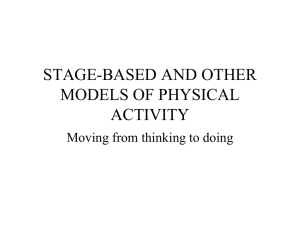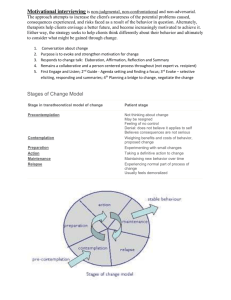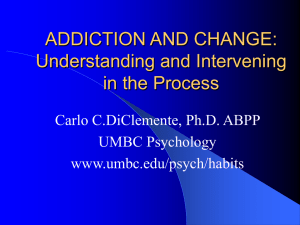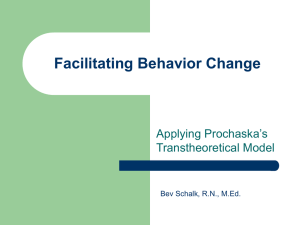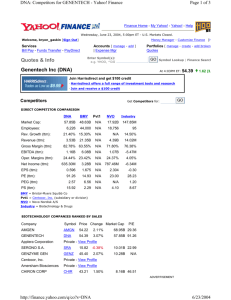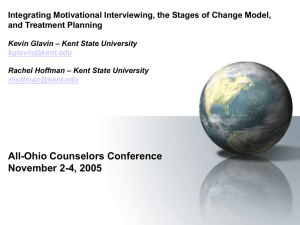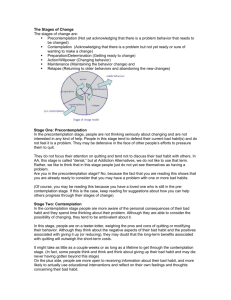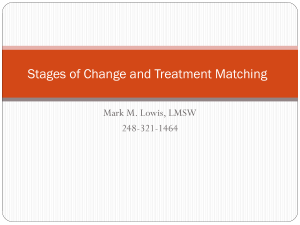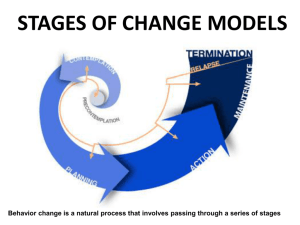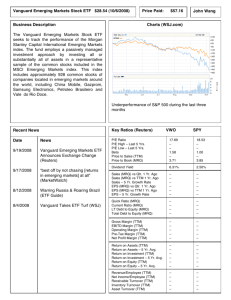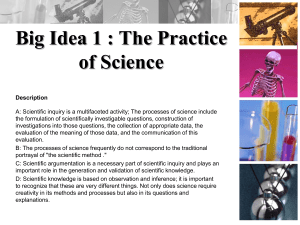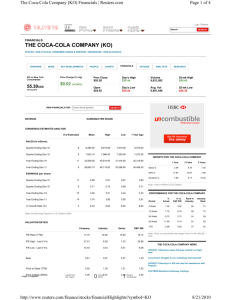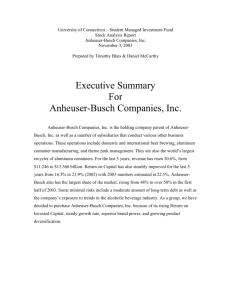How to use the stages of change
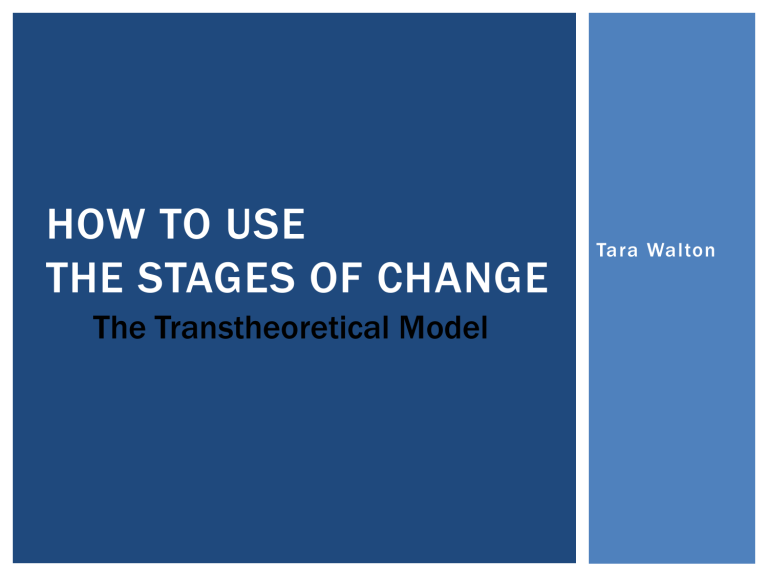
HOW TO USE
THE STAGES OF CHANGE
The Transtheoretical Model
Tara Walton
OBJECTIVES
Review the 4 constructs of the TTM
Review the 5 stages of behavior change
Learn how to apply TTM to change a behavior
Review strengths and limitations of TTM
STAGES OF CHANGE/
TRANSTHEORETICAL MODEL (TTM)
A model used to explain individual behavior change
Consists of 4 main constructs:
Stages of Change
Processes of Change
Decisional Balance
Self-efficacy
1. THE STAGES OF CHANGE
Pre contemplation
• “ignorance is bliss”
Termination
Relapse
•“Fall from grace”
Contemplation
•“fence sitting”
Maintenance
• “steady as she goes”
Action
•“go for it”
Preparation
•“testing the waters”
2. THE PROCESSES OF CHANGE
The covert and overt activities that people use to progress through stages
(Prochaska et al., 2002)
These strategies can be:
Cognitive
Affective
Behavioural
Application to specific stages can facilitate movement
Processes can help guide development of stage-specific interventions
3. DECISIONAL BALANCE
Relative weighing of the costs and benefits of changing the behaviour
motivation/readiness to change varies with each stage, relative to the balance of pro’s versus con’s of changing
4. SELF-EFFICACY
The situation-specific confidence that you have in your ability to change the behaviour
APPLYING THE STAGES OF CHANGE
HOW
Self Efficacy
Decisional Balance
Processes of change
WHEN
Stages of
Change
The stages of change help identify
WHEN a person is ready to change
Self efficacy, decisional balance, & process of change help to explain HOW to facilitate movement through the stages of change
APPLYING THE STAGES OF CHANGE
Precontemplation Contemplation Preparation
Consciousness Raising
Dramatic Relief
Environmental Re-evaluation
Self-Re-evaluation
Action Maintenance
Self-liberation
Counter-conditioning
Helping Relationships
Reinforcement Management
Stimulus Control
Pro’s of changing increasing
Pro’s of changing increasing
Self-efficacy increasing
HOW TO USE STAGES OF CHANGE
TO INCREASE SLEEP
PRECONTEMPLATION TO
CONTEMPLATION
Goal:
• increase the pro’s of changing
Process:
• Consciousness raising (increase awareness)
• Dramatic Relief (emotional arousal)
• Environmental Re-evaluation
PRECONTEMPLATION TO
CONTEMPLATION
This illustration can be used as educational material to help an individual understand some of the costs of sleep deprivation
CONTEMPLATION TO
PREPARATION
Goal:
• decrease the con’s of changing
Process:
• Self re-evaluation (self-reappraisal)
CONTEMPLATION TO
PREPARATION
Con’s
- Less time for friends
- Can’t watch as much tv
- Less time to study
- Might miss deadlines
Pro’s
- Helps repair the body
- Reduce stress
- Improve memory
- Control body weight
- Reduce mood disorders
PREPARATION TO ACTION
Goal:
• Pro’s of changing must outweigh con’s
• Increase self-efficacy
Process:
• Self-liberation (committing)
•New Year’s resolutions
•Provide several options vs one choice
•ie: 8 hrs of sleep 3 nights a week,
1 extra hr of sleep each night going to bed by midnight 5 nights/week
ACTION TO MAINTENANCE
Goal:
• Increase self-efficacy
Process:
• Counter-conditioning (substituting)
• Helping relationships (supporting)
• Reinforcement Management (rewarding)
• Stimulus Control (re-engineering)
STIMULUS CONTROL
This process includes using avoidance, environmental reengineering, and self-help groups
Example: Tips to help you sleep
Keep a regular sleep/wake schedule
Avoid caffeine 4-6 hrs before bed
Minimize daytime use
Avoid alcohol/heavy meals before bed
Get regular exercise
Minimize noise, light & excess temperatures where you sleep
STRENGTHS OF TTM
Individual focus: can be personally tailored
Recognizes behaviour change as dynamic and non-linear
Can help identify readiness to change
Link between stages & processes allows for targeted interventions
LIMITATIONS OF TTM
Does not consider:
environmental factors
social determinants
Focuses on primary prevention
Reducing risks vs preventing risks
May not be applicable to:
Specific populations
Complex health behaviors
Population health interventions
SUMMARY OF THE TTM
People move through different stages over time
Movement depends on:
the balance of pro’s and con’s
a person’s self-efficacy
Processes of change help move through stages
The model can be:
useful for facilitating individual behavior change
difficult to apply at the population health level
RESOURCES
Cancer prevention research center:
http://www.uri.edu/research/cprc/TTM/detailedoverview.htm
Mississippi State University:
http://www2.msstate.edu/%7Ebhunt/Stages_of_Change_Theory/ transtheoretical
.html
Prochaska, J. O. & DiClemente, C. C. (1984). The transtheoretical approach: Crossing traditional boundaries of treatment. Melbourne,
Florida: Krieger Publishing Company.
Prochaska, J.O., DiClemente, C.C., and Norcross, J.C. 1992. In Search of
How People Change: Applications to Addictive Behaviors. American
Psychologist 47(9): 1102-1114.
Prochaska, J.O., Johnson, S., and Lee, P. The Transtheoretical Model of
Behavior Change. In: Shumaker, S.A ., Schron, E.B., Ockene, J.K., and
McBee, W.L. [Editors]. 1998. The Handbook of Health Behavior Change,
2nd Ed. Springer Publishing Company.
